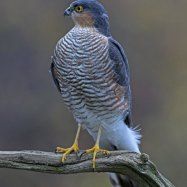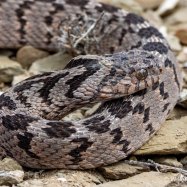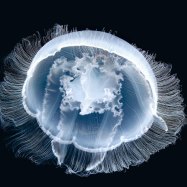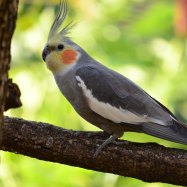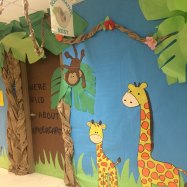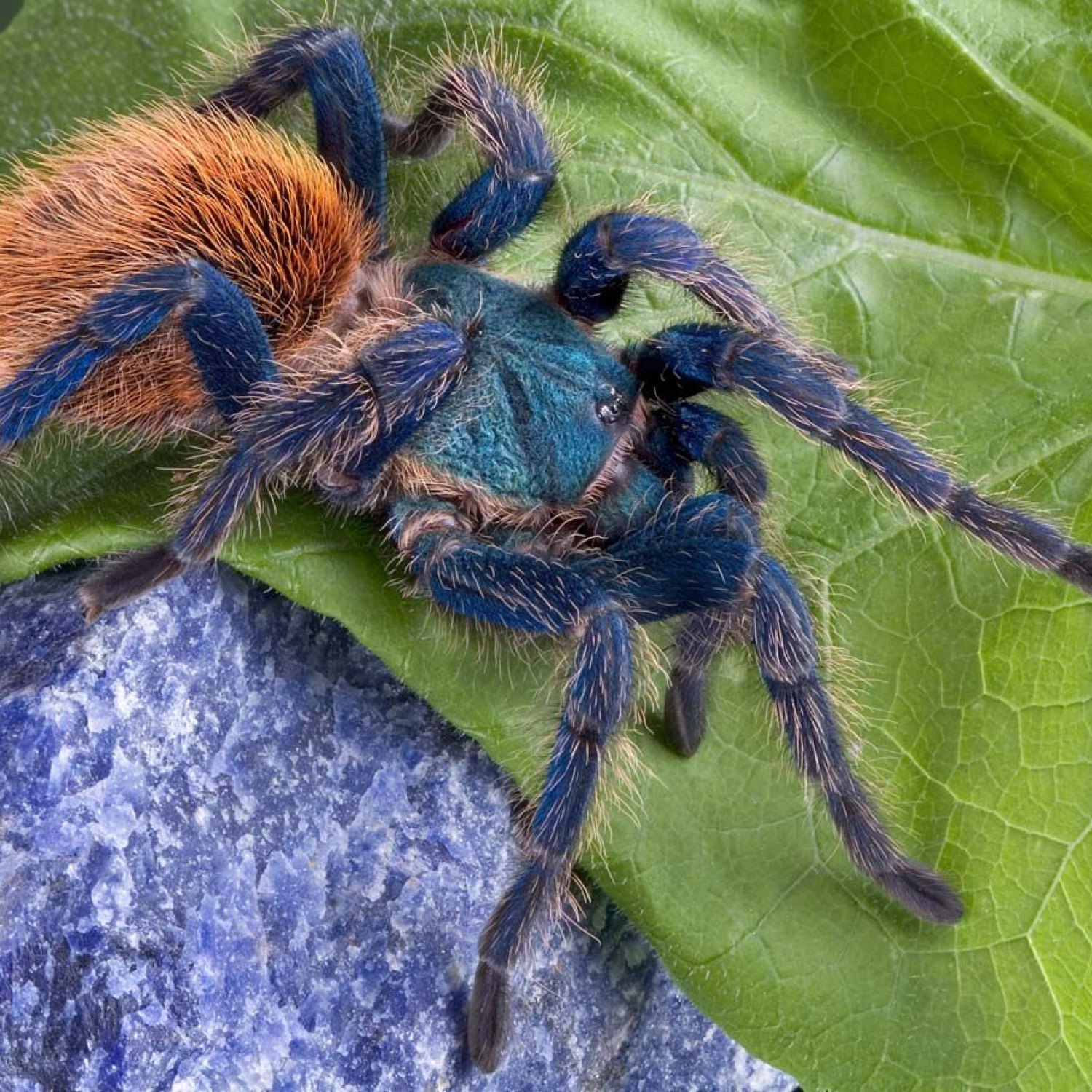
Green Bottle Blue Tarantula
Around 4-5 inches (10-12 cm)
The Green Bottle Blue Tarantula is a stunning species found in Northern South America. With a length of 4-5 inches and a bulbous abdomen, it belongs to the Theraphosidae family. Its bold colors and large size make it a popular choice among tarantula enthusiasts. #GreenBottleBlueTarantula #Theraphosidae #NorthernSouthAmerica
Animal Details Summary:
Common Name: Green Bottle Blue Tarantula
Kingdom: Animalia
Habitat: Terrestrial
The Beautiful Blue Tarantula: A Closer Look at the Green Bottle Blue Tarantula
When talking about tarantulas, most people tend to imagine a big, hairy and terrifying spider that is best kept far, far away from them. However, not all tarantulas are big and scary. In fact, some species such as the Green Bottle Blue Tarantula, also known as the Chromatopelma cyaneopubescens, are actually quite beautiful and intriguing creatures.For those who are unfamiliar, the Green Bottle Blue Tarantula is a beautiful and colorful tarantula native to the northern parts of South America, specifically Venezuela Green Bottle Blue Tarantula. Its scientific name, Chromatopelma cyaneopubescens, can be quite a mouthful for some, which is why it's commonly referred to as the Green Bottle Blue Tarantula or simply, GBB tarantula.
With its vibrant blue legs, orange abdomen, and metallic green carapace, it's not hard to see why this tarantula has earned the nickname "Green Bottle Blue". Its stunning coloration makes it stand out from other tarantula species, making it a popular choice for tarantula enthusiasts.
Classification and Habitat
The Green Bottle Blue Tarantula belongs to the kingdom Animalia, the phylum Arthropoda, and the class Arachnida. It is part of the order Araneae, which includes all spiders, and the family Theraphosidae, which includes all tarantulas.One interesting fact about the GBB tarantula is that it is a terrestrial species, meaning it prefers to live on the ground rather than up in trees like other tarantulas. Its natural habitat is usually in dry and scrubby areas, where it can find shelter in burrows and under rocks. In captivity, they can be kept in terrariums with plenty of substrate for burrowing and hiding, as well as decorations such as plants and logs for climbing.
Feeding and Hunting
Like all tarantulas, the Green Bottle Blue Tarantula is a carnivore and uses venom to subdue its prey Green Sunfish. In the wild, it feeds on a variety of insects, including crickets, cockroaches, and grasshoppers. In captivity, they can also be fed appropriately sized prey such as mealworms, superworms, and even live pinky mice.Being a terrestrial species, the GBB tarantula does not spin webs to catch its prey. Instead, it actively hunts for its food by using its sense of touch and sight. Unlike other tarantulas that rely on their sense of touch, the GBB tarantula's eyesight is exceptional, allowing it to easily locate and capture its prey.
Geographical Distribution and Country of Origin
As mentioned earlier, the Green Bottle Blue Tarantula is native to the northern parts of South America, specifically in Venezuela. However, due to their popularity as pets, they can now be found in other parts of the world, such as Europe and the United States.In the wild, GBB tarantulas are mostly found in dry and scrubby areas of Venezuela, where they can hide under rocks and in burrows. As pet tarantulas, they are relatively easy to find and can be purchased from reputable breeders or exotic pet stores.
Size and Body Shape
Compared to other tarantula species, the Green Bottle Blue Tarantula is considered fairly large, with an overall size of around 4-5 inches (10-12 cm). However, size can vary depending on factors such as genetics and environment.One distinct feature of the GBB tarantula is its bulbous abdomen, which gives it a rounder appearance compared to other tarantulas. This makes it easier to distinguish from other species, especially with its striking coloration.
Caring for Green Bottle Blue Tarantulas
If you're considering getting a Green Bottle Blue Tarantula as a pet, there are a few things you need to know to ensure proper care and maintenance.Firstly, it's important to provide a suitable and spacious enclosure for your tarantula. A 10-gallon tank is usually enough for an adult GBB tarantula, but bigger is always better. Make sure to provide enough substrate for burrowing and hiding, as well as decorations for climbing and exercising.
Secondly, temperature and humidity levels should be maintained at an appropriate level. The recommended temperature for GBB tarantulas is between 75-85°F (24-29°C) and humidity levels around 65-75%. You can achieve this by misting the enclosure with water regularly and using a hygrometer to monitor humidity levels.
Finally, make sure to provide a varied and balanced diet for your tarantula. As mentioned earlier, GBB tarantulas feed on a variety of insects in the wild, so make sure to offer different types of prey in captivity to ensure proper nutrition.
In Conclusion
In a world where tarantulas are often associated with fear and dread, the Green Bottle Blue Tarantula stands out as one of the most beautiful and unique species. Its stunning coloration, excellent eyesight, and terrestrial nature make it a fascinating choice for tarantula enthusiasts and pet owners.By understanding its natural habitat, feeding habits, and proper care, one can truly appreciate the beauty and behavior of these creatures. Whether you are a seasoned tarantula keeper or just starting out, the Green Bottle Blue Tarantula is definitely one species that will capture your attention and heart.

Green Bottle Blue Tarantula
Animal Details Green Bottle Blue Tarantula - Scientific Name: Chromatopelma cyaneopubescens
- Category: Animals G
- Scientific Name: Chromatopelma cyaneopubescens
- Common Name: Green Bottle Blue Tarantula
- Kingdom: Animalia
- Phylum: Arthropoda
- Class: Arachnida
- Order: Araneae
- Family: Theraphosidae
- Habitat: Terrestrial
- Feeding Method: Carnivorous
- Geographical Distribution: Native to northern parts of South America
- Country of Origin: Venezuela
- Location: Northern South America
- Animal Coloration: Vibrant blue legs, orange abdomen, and metallic green carapace
- Body Shape: Bulbous abdomen and fairly large overall size
- Length: Around 4-5 inches (10-12 cm)
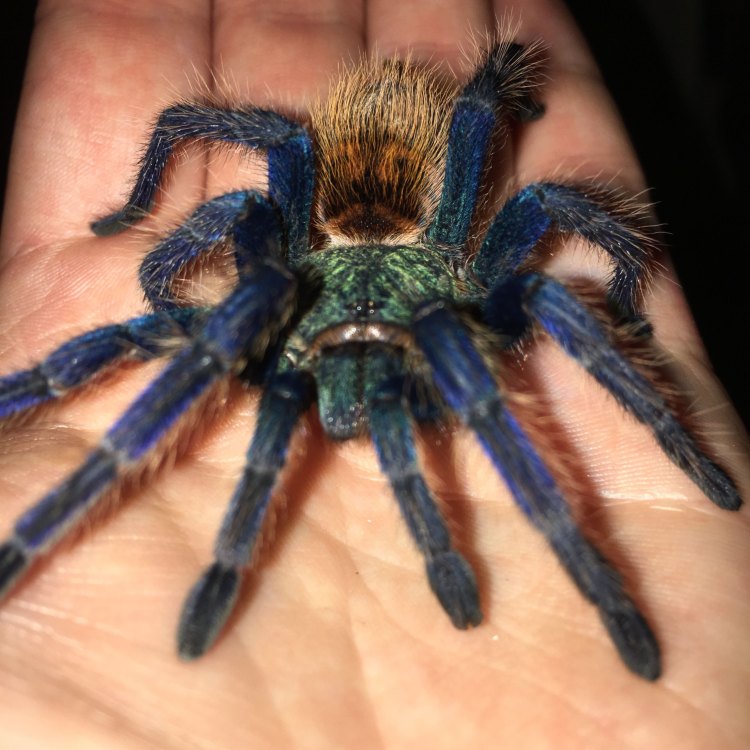
Green Bottle Blue Tarantula
- Adult Size: Around 6 inches (15 cm)
- Average Lifespan: 10-15 years
- Reproduction: Sexual
- Reproductive Behavior: Mating occurs when the male constructs a sperm web and performs a courtship dance
- Sound or Call: No vocalizations
- Migration Pattern: Non-migratory
- Social Groups: Solitary
- Behavior: Aggressive when threatened, has urticating hairs that can be flicked as a defense mechanism
- Threats: Habitat loss and collection for the pet trade
- Conservation Status: Not evaluated
- Impact on Ecosystem: Plays a role in controlling insect populations
- Human Use: Popular in the pet trade
- Distinctive Features: Vibrant blue and green coloration, elaborate web-building
- Interesting Facts: The female constructs an elaborate silk-lined burrow for its home
- Predator: Birds, mammals, and other large spiders
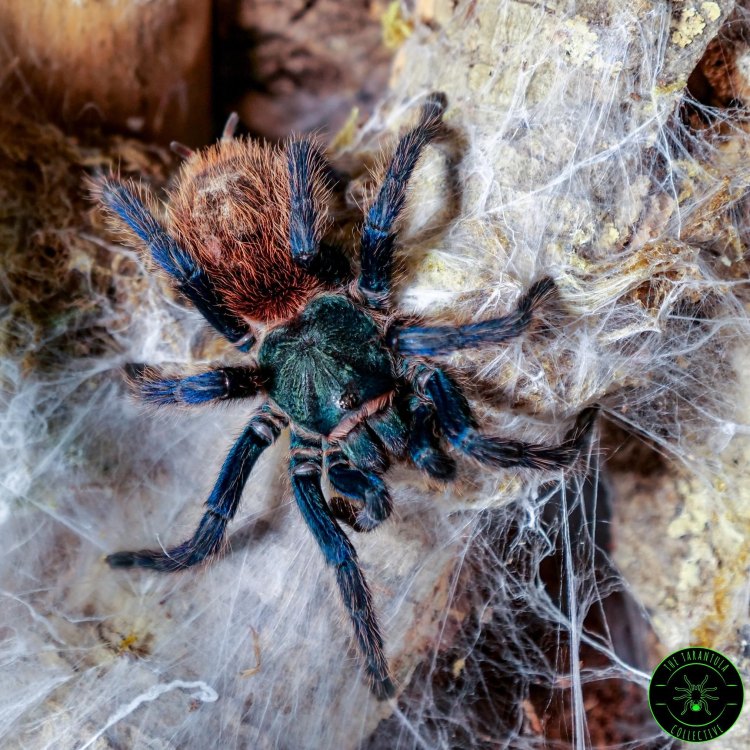
Chromatopelma cyaneopubescens
The Unique and Vibrant World of Green Bottle Blue Tarantulas
The world of arachnids is one that is often misunderstood and overlooked. These eight-legged creatures are often portrayed as scary and dangerous, but if we take a closer look, we will discover a fascinating and diverse world. One particular species that stands out is the Green Bottle Blue Tarantula, known for its vibrant colors and unique behaviors.Found in the wilds of Northern Venezuela and parts of Paraguay, the Green Bottle Blue Tarantula (Chromatopelma cyaneopubescens) is a medium-sized tarantula PeaceOfAnimals.Com. This species has earned its name due to its striking coloration, with bright blue legs, an orange abdomen, and a metallic green carapace. These colors are not only beautiful but also serve as a defense mechanism, as they blend into their natural habitat of moss, trees, and decaying leaves.
Adult Green Bottle Blue Tarantulas can reach a size of around 6 inches (15 cm) and have an average lifespan of 10-15 years. Like most spiders, they are sexual reproducers, with the male and female coming together for a brief period to mate. However, their unique reproductive behavior sets them apart from other tarantulas.
When it is time to mate, the male Green Bottle Blue constructs a sperm web, a special type of web used for holding and transferring sperm. He then performs an elaborate courtship dance to attract the female. This ritual can last for hours and includes shaking his legs and tapping the ground to create vibrations that can be felt by the female. This dance is not only for attracting the female but also serves as a way for the male to check if the female is receptive and not looking to eat him instead Gray Tree Frog.
Interestingly, Green Bottle Blue Tarantulas do not make any sound or call to communicate with each other. They rely on their keen sense of touch and vibrations to navigate their environment and communicate with potential mates.
While some tarantula species are known for their migratory patterns, the Green Bottle Blue is non-migratory and prefers to stay within its immediate surroundings. They are solitary creatures, only coming together briefly for mating and then going their separate ways.
In terms of behavior, the Green Bottle Blue Tarantula can be quite aggressive when threatened. They have sharp urticating hairs on their abdomen that they can flick as a defense mechanism. These hairs can irritate the skin and mucous membranes of potential predators, causing them to back off and leave the tarantula alone. However, these defense mechanisms are not always effective against larger predators, such as birds, mammals, and other large spiders.
Like many other species of tarantulas, Green Bottle Blues face threats in the wild, primarily habitat loss and collection for the pet trade. These striking tarantulas have gained popularity in the pet trade due to their beautiful colors and relatively calm nature, making them a desirable addition for tarantula enthusiasts. However, the harvesting of these tarantulas from their natural habitat can lead to a decline in their numbers, which raises concerns for their conservation status.
Currently, the Green Bottle Blue Tarantula is not evaluated by the IUCN Red List, but it is crucial to monitor their numbers and ensure sustainable practices if they are to remain a part of the wild's diverse ecosystem.
Despite their fearsome appearance, Green Bottle Blue Tarantulas play a significant role in controlling insect populations in their natural habitat. As predators, they feed mainly on insects and other small invertebrates, helping to keep their numbers in check. This delicate balance is essential for the ecosystem's health and highlights the importance of preserving this species in the wild.
Aside from their role in the ecosystem, Green Bottle Blue Tarantulas also have distinct features that set them apart from other tarantula species. Their striking coloration is the most obvious, but they are also known for their elaborate web-building skills. While most tarantulas use their webs primarily for protection, Green Bottle Blues are known to construct intricate silk-lined burrows to call home. These burrows can reach a depth of up to 18 inches and provide a safe and comfortable shelter for the tarantula.
In addition to their unique features, there are also some interesting facts about Green Bottle Blue Tarantulas that are worth mentioning. Did you know that they have a relatively short lifespan compared to other tarantula species? They generally only live for 10-15 years, while some tarantulas can live up to 30 years in captivity. This makes it all the more important to conserve and protect this species in their natural habitat.
Overall, the Green Bottle Blue Tarantula is a fascinating and unique species that deserves recognition and protection. Their striking colors, courtship dances, and elaborate web-building skills make them stand out in the world of spiders. However, as with all species, it is essential to respect their natural habitat and only obtain them through sustainable and ethical means, such as captive breeding programs.
So, the next time you come across a Green Bottle Blue Tarantula, instead of feeling fear, take a moment to appreciate the beauty and complexity of this incredible arachnid, and remember their importance in our world's delicate ecosystem.
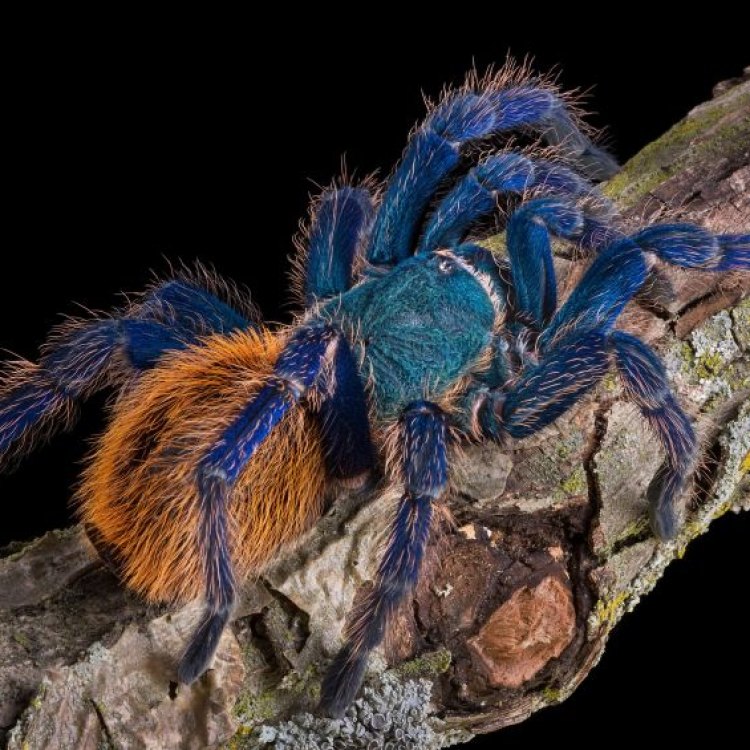
The Beautiful Blue Tarantula: A Closer Look at the Green Bottle Blue Tarantula
Disclaimer: The content provided is for informational purposes only. We cannot guarantee the accuracy of the information on this page 100%. All information provided here may change without prior notice.


